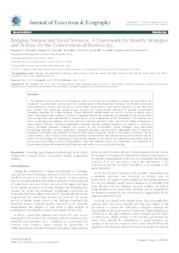Bridging natural and social sciences: a framework for identify strategies and actions for the conservation of biodiversity.
Bridging natural and social sciences: a framework for identify strategies and actions for the conservation of biodiversity.
Autoria: BERGALLO, H. G.; UZEDA, M. C.; FIDALGO, E. C. C.; SLUYS, M. V.; ALVES, M. A. S.; COSTA, T. C. C.; SANTOS, M. A.; COSTA, M. B.; COZZOLINO, A. C. R.; ROCHA, C. F. D.
Resumo: The Atlantic Forest is one of the most diverse areas in the world and considered a hotspot. Several actions are needed for its preservation, among them the implementation of the Biodiversity Corridors. The Atlantic Forest has three biodiversity corridors and the Rio de Janeiro State, which harbors huge species diversity, is in the Serra do Mar Corridor. We developed socioeconomic, political and environmental indicators to present conservation strategies supported by a wide database. These indicators complemented the previous surveys of priority areas which emphasized biotic elements, and their integration allowed the elaboration of strategies for the conservation and management, regionally directed, to support actions to be implemented by the Government. The analysis was done considering three subjects: Anthropic Pressure, Physical and Biotic State, and Present Ability of Response. Data analysis followed a synthesis-aggregation schedule and the resulting database was taken to a workshop, where specialists proposed strategies and actions for the conservation. These strategies were discussed considering vegetation remnant distribution, biological relevance, environmental vulnerability, kind of anthropic pressure in the region and potential for success of the actions proposed, based on the ability of response. Rio de Janeiro State is very diverse in biotic, physical, political, socioeconomic and cultural aspects which demand specific actions for each region. So, depending on the present situation of the natural and anthropic environments and on the present and future sources of degradation, regionally directed actions are applicable. This specificity in conservation actions will enable that the State remnants will be more successfully protected.
Ano de publicação: 2016
Tipo de publicação: Artigo de periódico
Unidade: Embrapa Solos
Observações
1 - Por padrão são exibidas publicações dos últimos 20 anos. Para encontrar publicações mais antigas, configure o filtro ano de publicação, colocando o ano a partir do qual você deseja encontrar publicações. O filtro está na coluna da esquerda na busca acima.
2 - Para ler algumas publicações da Embrapa (apenas as que estão em formato ePub), é necessário ter, no celular ou computador, um desses softwares gratuitos. Sistemas Android: Google Play Livros; IOS: iBooks; Windows e Linux: software Calibre.
Acesse outras publicações
Acesse a Base de Dados da Pesquisa Agropecuária (BDPA) para consultar o acervo completo das bibliotecas da Embrapa.

